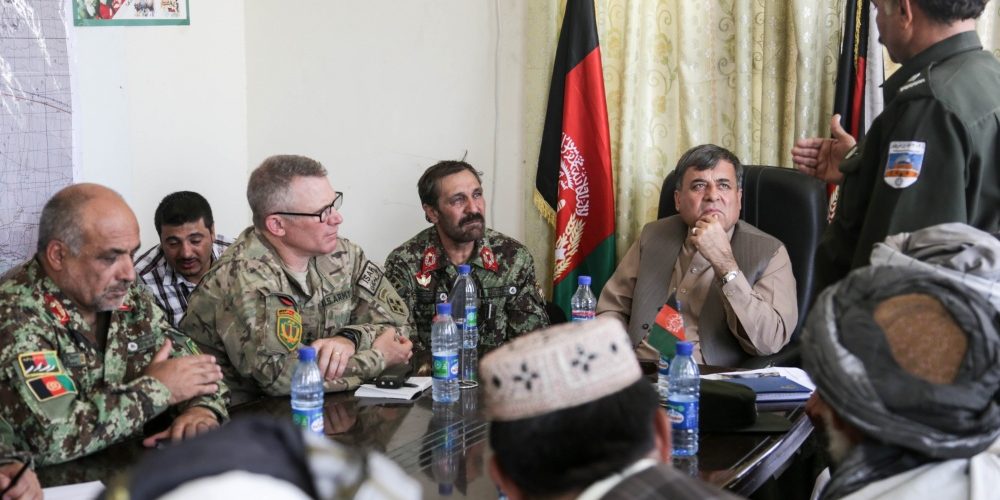I was the first anthropologist on a Human Terrain Team (HTT) to arrive in Iraq and contribute to an understanding of the social and cultural considerations that impact Army strategy, plans and operations. Shortly after my arrival in 2007, I received an email from Homeland Security asking if I felt Human Terrain Teams were appropriate for domestic security. I said that in principle, yes, but that I needed time to figure out my work since I was part of an experimental program still in need of validation. After seven years with the Human Terrain System, a program recently mothballed, I am confident the lessons and experiences from social science studies for the Army in Iraq and Afghanistan have direct relevance to improving the security of our nation.
Successfully achieving national security goals, whether abroad or domestically, depends on understanding the cultures and populations within which personnel operate. This is hardly a new concept. The U.S. Army’s Combat Training Institute, for example, published Through the Lens of Cultural Awareness: A Primer for US Armed Forces Deploying to Arab and Middle Eastern Countries. [1] That same year, the Marine Corps created the Center for Advanced Operational Culture Learning and produced a book entitled, Operational Culture for the Warfighter, which still remains relevant given its firm grounding in theories of social organization, change and meaning. [2] More recently, edited collections, such as Operational Relevance of Behavior and Social Science to DoD Missions, have made the sound argument that the intelligence community needs to change how it conducts analysis by incorporating social and behavioral science insight regarding complex and less predictable operational and strategic environments. As MG Flynn said in the preface to that publication, “America’s security environment faces a diverse set of challenges, all of which are shaped by sociocultural dynamics.” [3]
How do we meet the challenges operational and strategic environments pose? I propose that part of the answer is found in the lessons learned from the Army’s use of Human Terrain Teams. Seven years of deployed social science show that obtaining accurate, timely and relevant sociocultural insight to use in planning processes requires researchers working with the population in question and alongside security personnel responsible for a given area. The level of accuracy and relevance needed in regards to cultures cannot be obtained from computer simulations, remote sensing systems and reach-back centers, or by sifting through documents and reports on a hard drive or the internet. Although these options may add value, they remain insufficient.
Social science support for planning, decision-making and developing a shared understanding of the human domain requires being in the field. This equates to interdisciplinary social science teams conducting research among the population and interacting with stakeholders on the ground.
Controversy surrounded HTTs for many years, but a hard won lesson for myself and others deployed in support of warfighters was that a deliberate research product was needed. This product needed to have clear input for the general operations process and the specific integrated planning process. First, by being on the ground and using theoretically framed research questions and systematic analysis, social science teams could help decision makers and their staffs understand the what, so what and now what of the human domain to improve planning, execution and assessment of operations. This entailed clear input for understanding the Operating Environment (OE), visualizing and describing it, and assessing outcomes. A deliberate product called the Sociocultural Running Estimate was eventually created to achieve this tie-in and is continuously maintained. This process and product will serve Homeland Security planning and operations well and should be adopted to improve how the intelligence community helps decision makers develop a shared and systemic understanding of complex, unpredictable, rapidly changing operating environments domestically and transnationally.
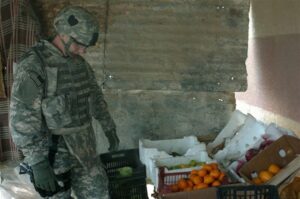
Marcus Griffin, an anthropologist working for the 101st Airborne Division’s 2nd Brigade Combat Team, inspects a fruit stand in Ghazaliyah, Iraq, while on patrol Jan. 13, 2008. Griffin is helping soldiers better understand the needs of the Iraqi people. (U.S. Army photo by Sgt. James P. Hunter, USA/Released)
Human Terrain Teams
HTTs were five person teams that served as the deployed element of the U.S. Army’s Human Terrain System (HTS). It was the only Army organization with a dedicated and trained capability to conduct field-based, social science research and analysis in pursuit of sociocultural understanding. At its zenith, there were over thirty teams deployed simultaneously in Iraq and Afghanistan. Each HTT was assigned to a deployed unit, reported to the commander and aided his staff in a way that best supported unit operations. The purpose and function of the HTT was to seek sociocultural understanding of local populations to allow for culturally astute decision-making. In terms of the Army’s operations process, the HTT enhanced the commander’s ability to Understand, Visualize and Describe the operational environment in terms of the human terrain; Direct detailed planning that took into account the human aspects of the environment; Lead through socioculturally-savvy decision-making; and then Assess the human effects of military operations and make adjustments accordingly.
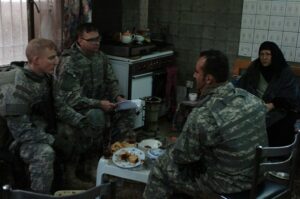
Army Capt. Thomas H. Melton, a native of Shreveport, La., and commander of Troop A, 1st Squadron, 75th Cavalry Regiment, and Marcus Griffin, an anthropologist for the 101st Airborne Division’s 2nd Brigade Combat Team, talk with an Iraqi woman inside her home in Ghazaliyah, Iraq, Jan. 13, 2008. Griffin is helping soldiers better understand the needs and living condi-tions of the Iraqi people. (U.S. Army photo by Sgt. James P. Hunter, USA/Released)
In addition to facilitating the principles of planning, they also engaged in planning activities by closely studying operational variables. The HTT’s method of analysis incorporated the Army’s strategic and operational variable frameworks but complemented them by
continuously maintaining a Sociocultural Running Estimate and looking at the OE in terms of the following categories:
Identities
Values, Beliefs, Behaviors, Norms (VBBN)
Conflict resolution mechanisms
Political system
Economic system
Social safety nets
Demographics
Cultural geography
Essential services
Religion
Communication media
Pattern of Life analysis
Examples of Work from Iraq
Below are three examples of my work in Iraq, illustrating the importance of working with staff officers in a Brigade Combat Team and mingling with the local population. Without being physically among the Soldiers, understanding the local population’s physical and social context through first hand observation and interaction, or appreciating the nuances of the problems faced by commanders and their staff, contributions to Soldiers would not occur. The necessity to explore research questions among populations in the United States and elsewhere as well as working alongside Homeland Security planning staffs or those engaged in Defense Support to Civilian Authorities are equally important for addressing domestic security.
The first example highlights the need to listen and respond to the problems staff officers grapple with routinely. In 2008, a Civil Military Operations staff officer (S9) was deciding what to do about a run-down bread factory, and he needed to produce a slide for the next day’s briefing to the commander. The S9 already knew about the costs associated with refurbishing the facility and the likelihood that replacement parts would need to be custom built. I discussed with him how the bread factory fit into the system of bread production and consumption in the area. Mass produced bread would reduce the cost for local consumers, but we needed to know the impact on neighborhood bakeries. We also needed to determine if production and distribution of bread in homes by women was important to the maintenance of social relations within the family and community. The officer and I came up with a potential way ahead and information that he used to brief the commander.
This shows that social science researchers need to be alongside planners and staff responsible for helping decision-makers understand, visualize, describe and assess their Area of Operations (AO) in all its complexity and detail. This is true for the Department of Defense and Homeland Security. Agency planners cannot be expected to know how societies function or malfunction, or how the social fabric is woven or torn through changes in relationships associated with production. An applied researcher working alongside can be expected to catch nuances in need of attention and deliberation so that unintended consequences do not compromise mission success and cause community alienation or harm.
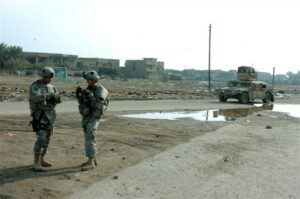
Army Capt. Thomas H. Melton, commander of Troop A, 1st Squadron, 75th Cavalry Regiment, and Marcus Griffin, anthropologist for the 101st Airborne Division’s 2nd Brigade Combat Team, talk while on patrol in Ghazaliyah, Iraq, Jan. 13, 2008. (U.S. Army photo by Sgt. James P. Hunter, USA/Released)
The second example demonstrates the need to go out among the local population and provide timely operational support. Violence was significant in the AO, and the commander wanted to know if infusing a specific neighborhood with significant business and community development money would cause the local population to be less tolerant of the insurgents hiding in empty houses and causing violence. I went out into the community and talked with locals about how they went about their daily life. I examined available goods and services in the local markets and plotted the kinds of houses and their architecture. I spoke with a variety of men I encountered along neighborhood streets and discussed the presence or absence of extended kin within the community with them. I added historical data about the neighborhood to what people were telling me, what I was seeing in the built environment of the neighborhood and how people moved within it. While I only had a single day, I still was able to confidently conclude that development monies would not have the desired effect. This was clear by taking multiple data points into consideration: the relative well-being of the population evidenced by what they were consuming; the lack of family members within a walking distance, contributing to social isolation; the high-walled architecture of houses discouraged interest in what neighbors were doing; and a few other considerations. As a result of being there for immediate operational support, the commander was able to consider the sociocultural evidence presented and turned his attention to other Courses of Action (COA). The unit avoided wasting three million dollars on a project that would have likely failed.
The lesson here is that for some decisions, a leader needs timely input based on field data. This data suffers from a bias caused by small sample sizes, but the triangulation of data still produces a compelling, qualitative description and explanation of what is going on in a specific place at a specific time. Secondary data found in prior reports and publications or primary data found in existing data sets will provide complementary insight, but they are insufficient by themselves. Homeland Security personnel may use research centers, commercial databases, census data and more than internet search engines, but proactive field research conducted as part of the planning process is vital to success.
The final example involves a unit that needed a better understanding of who the influential members of the community were. Link diagrams of who was who in the AO did not lead to an understanding of the local power dynamics. This was an obvious point of frustration for the commander during Intel Update briefs. The HTT approached the unit’s Assistant S2 and explained that the team could conduct a Community Power Study. Using data on who attended District Advisory Committee and Neighborhood Advisory Committee meetings, who was present at a variety of Key Leader Engagements throughout the AO, who held formal positions in local government, who was winning local contracts, who were the known tribal leaders and other data, the HTT engaged in a social network analysis. The result was a sociogram that characterized its density and cohesion as well as relationship tie strength. The social distance of leaders in relation to each other was described through the number of common connections and visually represented mathematically by the distance between members in the sociogram. This highlighted individuals who likely had social and economic influence over others. The network paths illustrated in the sociogram suggested how the unit might influence specific key leaders with messaging and social pressure through intermediaries in the group. The sociogram also showed which individuals may have been proxies for other leaders, suggesting the need for further inquiry on those hidden people of influence.
The research product not only contributed to a more robust Intel Update, the product helped to ensure message synchronization by subordinate units to members in the network.
This example makes a point that is often overlooked: social science today takes teamwork and unified effort. If not integrated into a staff, getting out into the field and fusing data from across the force for common benefit, then social scientists cannot do their job. As we look at countering domestic threats and building partnerships with other nations to achieve national security objectives, social science as part of Homeland Security must be done as part of group effort. The strategic and operational environments are simply too complex and answers are needed too quickly to conceive of lone researchers doing their own thing.
The Sociocultural Running Estimate
Since 2006, researchers on HTTs have produced many useful reports based on getting outside the wire. They have provided useful input for daily operations in Iraq and Afghanistan through participation in working groups and enduring the innumerable meetings that characterize a unit’s daily battle rhythm alongside Soldiers. Operational relevance of research was most often ensured by reverse engineering Priority Intelligence Requirements and the Commander’s Critical Information Requirements. However, it took years of creative and critical work to determine that participation by HTTs in the planning process required a more deliberate, standard method: the creation and maintenance of a sociocultural running estimate. By approaching the human domain using social theory-based research to produce a running estimate, shared and systemic understanding of the OE across a unit and between echelons could be effectively and efficiently produced with a much greater return on investment and lower opportunity cost than previously. The three examples of research described above show a greater return on investment by contributing data to the maintenance of the sociocultural running estimate.
The following three sociocultural running estimate concerns are the first action steps for generating a shared understanding of the OE. This is necessary for conceptual and detailed planning and the ability to operate successfully among the population. The information listed below stands on its own (the what) but becomes more powerful when analysis explains the interconnections between content (the so what). Understanding how sociocultural information is linked together in a complex system is necessary for mission success and can often lead to better Course of Action Development (the now what). The three sets of information are:
What are the meaningful social groups to which people belong?
Who leads these groups in the community; for what issues or domains do they have authority?
What is the community’s cultural narrative that binds the people together through common values, beliefs, behaviors and norms?
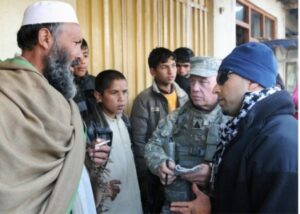
Ed Campbell, Department of the Army employee with the Human Terrain Team from Task Force Cyclone, and his in-terpreter stop and talk with a local shop owner in the city of Bagram in Parwan province, Afghanistan. (U.S. Army photo by Spc. Charles Thompson/Released)
The importance of this information comes not from, for example, listing the meaningful social groups in an area, but knowing how the cultural narratives are similar and dissimilar across the groups (associating 1 with 3). The sociocultural content found in each of the three questions, when treated as elements in a complex system, leads to evidence-based understanding of the OE.
Each question, presented as a research task for social science teams to conduct, is as follows:
A. Meaningful social groups
1) Group identities
2) Group size, relative to one another
3) Key characteristics/ideologies defining membership
4) Geographic location or areas of control and areas contested by groups
5) Historical grievances between social groups; current status of these grievances
6) Social groups vulnerable to spoiler intimidation, messaging and recruitment (alienated, disenfranchised or oppressed)
B. Social group leadership; issues or domains of authority
1) Conduct a Community Power Study
2) Formal and informal influence in a community
3) Local bases of power, wealth and prestige. Common Bases of power, wealth and prestige include:
a.) Educational attainment
b.) Holding past and present formal positions of authority
c.) Ownership of land, commercial property, farms, apartment/housing tracts, markets/stores
4) Formal leadership positions in civil government (Who, What, When)
5) Formal leadership positions in public life (business, tribe/family/ethnic, religion) (Who, What, When)
6) Local leaders based on achieved status (doctors, judges, retired senior military officers, wealthy heads of family and successful business people)
7) Overlap of individuals occupying multiple positions of influence
8) Overlap Analysis
a) Biographies of leaders
b) Issues/people they influence
c) Gaps in leadership
d) Relationships: who knows whom and how among the leadership networks
C. Cultural Narrative Analysis: Community’s Cultural Narrative – binding people together through common values, beliefs, behaviors and norms
1) Grade school textbook and religious learning materials analysis:
a.) Basic textbook themes relating to appropriate and inappropriate behavior, personal and community identity, and common beliefs and any forms of punishment for violating accepted norm
b.) List of themes and ways in which they are illustrated through stories and pictures; these form the foundation of the community’s cultural narrative of who they consider themselves to be, who outsiders are, and what beliefs, behaviors, values and norms characterize members of the community
c.) Messaging themes for greatest compatibility with the community
2) Narratives of religious and other community leaders speaking at public events, non-state actor propaganda, lyrics to popular local songs and media broadcasts
a.) Basic themes relating to appropriate and inappropriate behavior, personal and community identity, and common belief and any forms of punishment for violating accepted norms; themes and the ways they are illustrated form the foundation of the community’s counter-narrative to the dominant society’s Cultural Narrative
b.) Theme comparison as Step 1 above for similarity and dissimilarity
c.) Messaging themes for greatest compatibility with the community
The results from each of the three tasks must be continuously maintained in order to have a sociocultural running estimate available for use in integrated planning. The data and analysis that accumulates allows for a robust contribution to a unit’s Common Operating Picture development and continuous assessment of the OE.
Conclusion
The DoD experience in Iraq and Afghanistan suggests Homeland Security agencies need social scientists skilled at field research as part of their planning and operations teams. This allows the agency to be ahead of the game when cultural and religious communities need to be engaged or a response to a crisis is required. Understanding culture and applying it to domestic and transnational problem sets takes significant education, training and on-the-job synthesis. This job cannot be accomplished as a collateral duty. With dedicated, field-experienced social scientists alongside them, agencies and departments can more readily work with the people on the ground and more effectively shape their OE. Because all culture is locally lived, researchers can provide agency personnel with descriptions and explanations of local worldviews of cultural communities, leadership and power networks, dominant and counter narratives, and an understanding of how social institutions function in the lives of local people. This is the method and practice necessary to ensure the best possible results. By doing this, Homeland Security may work effectively with civilian populations through shared understanding and thereby promote community safety and mission success.
References:
[1] Wunderle, William D. Through the Lens of Cultural Awareness: A Primer for US Armed Forces Deploying to Arab and Middle Eastern Countries. Fort Leavenworth, KS: Combat Studies Institute Press 2006.
[2] Salmoni, Barak A. and Paula Holmes-Eber. Operational Culture for the Warfighter:Principles and Applications. Quantico, VA: Marine Corps University Press. 2008.
[3] Canna, Sarah. Operational Relevance of Behavior and Social Science to DoD Missions. Washington, DC: Strategic Multilayer Assessment Program, Office of the Secretary of Defense. March 2013.
About the Author:
Dr. Marcus Griffin is a cultural anthropologist with significant experience providing research support to the U.S. Army and Marines, including the recently completed ARI research effort in Optimizing an Integrated Planning System. Marcus was the lead social scientist for one of the first Army Human Terrain System Teams, deploying to Baghdad, Iraq and providing research support and instructing two Brigade Combat Teams and one Marine Expeditionary Force in in how to apply ethnography to understanding their environment. Because of his ability to derive and impart lessons learned and best practices from the integration of social sciences with planning, stability operations and community development, Marcus was selected to serve as the Dean of Academics for the Human Terrain System, where he led a transformation of the education and training of Human Terrain System Teams and team members. Marcus is the author numerous articles and of the first integrated cultural research management plans for the XVIII Airborne Corps, the United States Marine Corps, the United States Navy and the U.S. Army Corps of Engineers. He is the past Associate Professor of Sociology and Anthropology at Christopher Newport College, where for nine years he developed and delivered thirteen courses.


